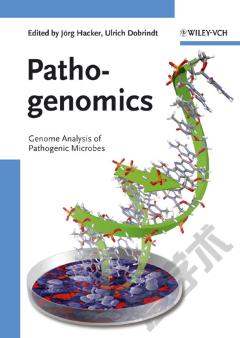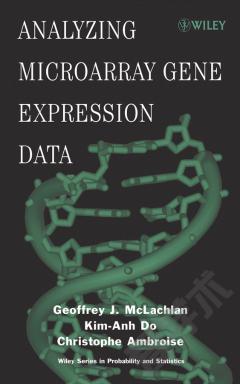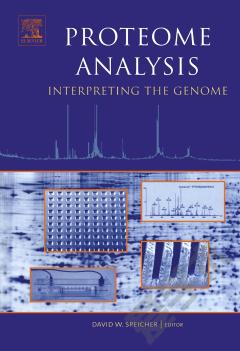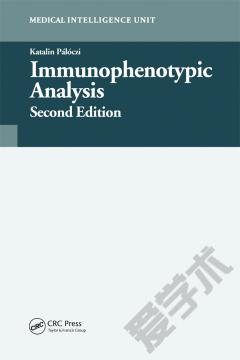Pathogenomics —— Genome Analysis of Pathogenic Microbes
----- 致病基因组学:致病微生物基因组分析
Foreword. Preface. List of Contributors. Color Plates. I Methods. 1 Bioinformatics: Data Mining Among Genome Sequences (Susanne Kneitz and Thomas Dandekar). 1.1 Systematic Genome Analysis of Pathogens as a Basis for Pharmacogenomic Strategies. 1.2 Direct Sequence Annotation Tools for Functional Genomics. 1.3 Identification of Protein Function. 1.4 Obtaining Protein Information from a Domain Server. 1.5 Pathway Analysis. 1.6 Network Analysis. 1.7 Adaptation in Time and to Stimuli. 1.8 Pathogen-Specific Challenges. 1.9 Pathogen Adaptation Potential. 1.10 The Fight Against Resistance. 1.11 Drug Design and Antibiotics. 1.12 Annotation Platforms Suitable for Pathogenomics. 1.13 Conclusions. 2 Transcriptome Analysis: Towards a Comprehensive Understanding of Global Transcription Activity (Ben Sidders and Neil Stoker). 2.1 Introduction. 2.2 Development of Transcriptomics. 2.3 Introducing the Microarray. 2.4 Microarray Methods. 2.5 Data Normalization and Analysis. 2.6 Transcriptomics: Where We Are Now and What's to Come. 3 Physiological Proteomics of Bacillus subtilis and Staphylococcus aureus: Towards a Comprehensive Understanding of Cell Physiology and Pathogenicity (Michael Hecker and Susanne Engelmann). 3.1 Introduction. 3.2 Proteomics of Bacillus subtilis: The Gram-positive Model Organism. 3.3 Physiological Proteomics of Staphylococcus aureus. 3.4 Outlook: Second Generation Proteomics and New Fields in S. aureus Physiology and Infection Biology. 4 Impact of Genome Sequences on Mutational Analysis of Fungal and Bacterial Pathogens (Vladimir Pelicic and Xavier Nassif). 4.1 The Long Road from Sequence to Function. 4.2 Classical Genetics Still at the Forefront in the Postgenome Era. 4.3 Genome-Scale Mutational Analyses. 4.4 Conclusion. II Genomics of Pathogenic Bacteria. 5 Pathogenomics of Escherichia coli and Shigella Species (Ulrich Dobrindt and Jorg Hacker). 5.1 Introduction. 5.2 Comparative Genomics of Shigella. 5.3 Comparative Genomics of Escherichia coli. 5.4 Conclusions. 6 Pathogenomics of Salmonella Species (Helene Andrews-Polymenis and Andreas J. Baumler). 6.1 Introduction. 6.2 Salmonella Signature Genes. 6.3 Subspecies I Signature Genes. 6.4 Host Restriction. 7 Pathogenomics of Enterococcus faecalis (Janet M. Manson and Michael S. Gilmore). 7.1 Introduction. 7.2 Enterococcal Pathogenesis. 7.3 Genome Sequence of E. faecalis. 7.4 Conclusions and Future Perspectives. 8 Genomics of Streptococci (Joseph J. Ferretti and W. Michael McShan). 8.1 Introduction. 8.2 Bacterial Genomes. 8.3 Streptococcal Genomic Bacteriophages. 9 Pathogenic Staphylococci: Lessons from Comparative Genomics (Knut Ohlsen, Martin Eckart, Christian H1ttinger, and Wilma Ziebuhr). 9.1 Introduction. 9.2 Comparative Genomics of S. aureus. 9.3 Staphylococcus epidermidis. 9.4 Concluding Remarks. 10 Pathogenomics: Insights into Tuberculosis and Related Mycobacterial Diseases (Alexander S. Pym, Stephen V. Gordon, and Roland Brosch). 10.1 Introduction. 10.2 Molecular Basis of Pathogenicity. 10.3 Evolution of the M. tuberculosis Complex. 10.4 Some Metabolic Insight from the Genome Sequences. 10.5 Other Major Mycobacterial Human Pathogens. 10.6 Concluding Remarks. 11 Genomes of Pathogenic Neisseria Species (Christoph Schoen, Heike Claus, Ulrich Vogel, and Matthias Frosch). 11.1 Introduction. 11.2 Genomes of Pathogenic Neisseria Species. 11.3 Future Perspectives. 12 Genomics of Pathogenic Clostridia and Bacilli (Armin Ehrenreich, Gerhard Gottschalk, and Holger Bruggemann). 12.1 Genomics of Pathogenic Clostridia spp. 12.2 Genomics of Pathogenic Bacilli. 13 The Genomes of Pathogenic Bartonella Species (Carolin Frank, Eva Berglund, and Siv G. E. Andersson). 13.1 Introduction. 13.2 Bartonella Species and Pathogenicity. 13.3 The Bartonella Genomes. 13.4 Genomic Islands and Phages. 13.5 Genomic Islands and Phages in Bartonella Species. 13.6 The Chromosome II-Like Segment in Bartonella. 13.7 B. quintana's Evolution into a Human Pathogen. 13.8 Conclusions and Future Perspectives. 14 Pathogenomics of Gastric and Enterohepatic Helicobacter Species (Sebastian Suerbaum, Sandra Schwarz, and Christine Josenhans). 14.1 Introduction. 14.2 Helicobacter pylori. 14.3 Helicobacter hepaticus. 14.4 Genome Comparisons of Gastric and Enterohepatic Helicobacter Species with Related Bacteria. 14.5 Outlook. 15 Genomics of the Opportunistic Pathogen Legionella pneumophila (Christel Cazalet and Carmen Buchrieser). 15.1 The Genus Legionella: Epidemiology, Life Cycle, and Pathogenesis. 15.2 Genomics of Legionella pneumophila. 15.3 Specific Features of the Legionella Genomes. 15.4 Conclusions. 16 Genomics of Listeria monocytogenes (Michael Kuhn and Werner Goebel). 16.1 Introduction: From Pregenomics to Postgenomics. 16.2 Listeria monocytogenes: A Facultative Intracellular Pathogen. 16.3 Listeria monocytogenes Genetics in the Pregenomic Era: Identification and Characterization of Important Virulence Factors. 16.4 Genome Sequence of L. monocytogenes and Its Comparison with the Closely Related L. innocua. 16.5 Genomic Approaches to Studying the other Members of the Genus Listeria. 16.6 Evolutionary Aspects. 16.7 Identification of Listerial Virulence Factors in the Postgenomic Era. 16.8 Proteomics. 16.9 Transcriptomics. 16.10 Conclusions. III Genomics of Pathogens and Their Hosts: Applications. 17 Genomics of Viruses (Esteban Domingo, Alejandro Brun, Jose Ignacio Nunez, Juan Cristina, Carlos Briones, and Cristina Escarmis). 17.1 Introduction: Wide Scope of Virogenomics. 17.2 Retrieving Information. 17.3 Applications of Data Banks to Virology. 17.4 Beyond Reference Strains: Towards a Second-Generation Virogenomics? 17.5 Virogenomics Through Microarrays. 18 Genomics of Pathogenic Fungi (Gerwald A. Kohler, Alan Kuo, George Newport, and Nina Agabian). 18.1 Introduction. 18.2 Genomics of Primary Fungal Pathogens. 18.3 Genomics of Opportunistic Fungal Pathogens. 18.4 The Tool Box for Functional Genomics. 18.5 Fungal Virulence - From the Genomic Point of View. 18.6 Conclusion. 19 Genomics of Pathogenic Parasites (Gabriele Pradel and Thomas James Templeton). 19.1 Exploring the Genomes of Pathogenic Protozoans. 19.2 The Shaping of the Proteomes of the Pathogenic Protists. 19.3 Role of Horizontal Gene Transfer in Protozoan Genome Plasticity. 19.4 The Apicomplexa. 19.5 The Pathogenic Kinetoplastids. 19.6 The Pathogenic Diplomanad Giardia and the Parabasalid Trichomonas. 19.7 Postgenomic Strategies and the Search for Cure. 20 Model Host Systems: Tools for Comprehensive Analysis of Host-Pathogen Interactions (Michael Steinert and Gernot Glockner). 20.1 Introduction. 20.2 Host-Pathogen Interactions. 20.3 Arabidopsis thaliana: A Plant as a Model for Human Disease. 20.4 Dictyostelium discoideum: Perspectives from a Social Amoeba. 20.5 Caenorhabditis elegans: Answers from a Worm. 20.6 Drosophila melanogaster: A Fruitful Model. 20.7 Danio rerio: Fishing for Knowledge. 20.8 Mus musculus: Of Mice and Men. 20.9 Clean Models and Dirty Reality. 21 Expression Analysis of Human Genes During Infection (Erwin Bohn and Ingo B. Autenrieth). 21.1 Introduction. 21.2 Comparison of Gene Expression Profiles of Macrophages and Dendritic Cells In Vitro Upon Infection with Different Pathogens. 21.3 Septicemia. 21.4 Gene Expression in Epithelial Cells Modulated by Bacteria. 21.5 Common Signatures. 21.6 Genetic Polymorphisms and Mutations Affect Gene Expression: Impact on Infection Susceptibility and Infection Course. 21.7 Concluding Remarks. 22 Pathogenomics: Application and New Diagnostic Tools (Soren Schubert and Jurgen Heesemann). 22.1 Introduction: "In Our Hands". 22.2 Microbiological Diagnostics of Bacterial Pathogens: Aims, Tasks, and Current Limitations. 22.3 The Pregenomic Era: Conventional and Molecular Methods in Microbiological Diagnostics. 22.4 The Postgenomic Era: Use of DNA Microarrays in the Diagnosis of Infectious Diseases in Humans and Animals. 22.5 Microarray Technology in Bacteria: Further Areas of Applications. 22.6 Current Limitations on the Use of DNA Microarrays in Diagnostics in Medical Microbiological Laboratories. 22.7 Final Remarks. 23 The Search for New Antibiotics (Harald Labischinski, Christoph Freiberg, and Heike Brotz-Oesterhelt). 23.1 The Need for Novel Antibiotics. 23.2 Where Will the New Antibiotics Come From? 23.3 Contributions of Genomic Technologies to Antibacterial Research. 23.4 Alternative Approaches in Antibacterial Drug Discovery. 24 Reverse Vaccinology: Revolutionizing the Approach to Vaccine Design (Laura Serino, Mariagrazia Pizza, and Rino Rappuoli). 24.1 Impact of Genomics on Vaccine Design. 24.2 MenB Vaccine Approach by Reverse Vaccinology. 24.3 Following the MenB Experience: Other Pathogens. 24.4 Functional Genomics. 24.5 Gene Expression In Vivo: IVET and STM. 24.6 Transcriptome Analysis and Comparative Genomics. 24.7 Proteomics and Vaccine Design. 24.8 Conclusions. Index.
{{comment.content}}








 京公网安备 11010802027623号
京公网安备 11010802027623号